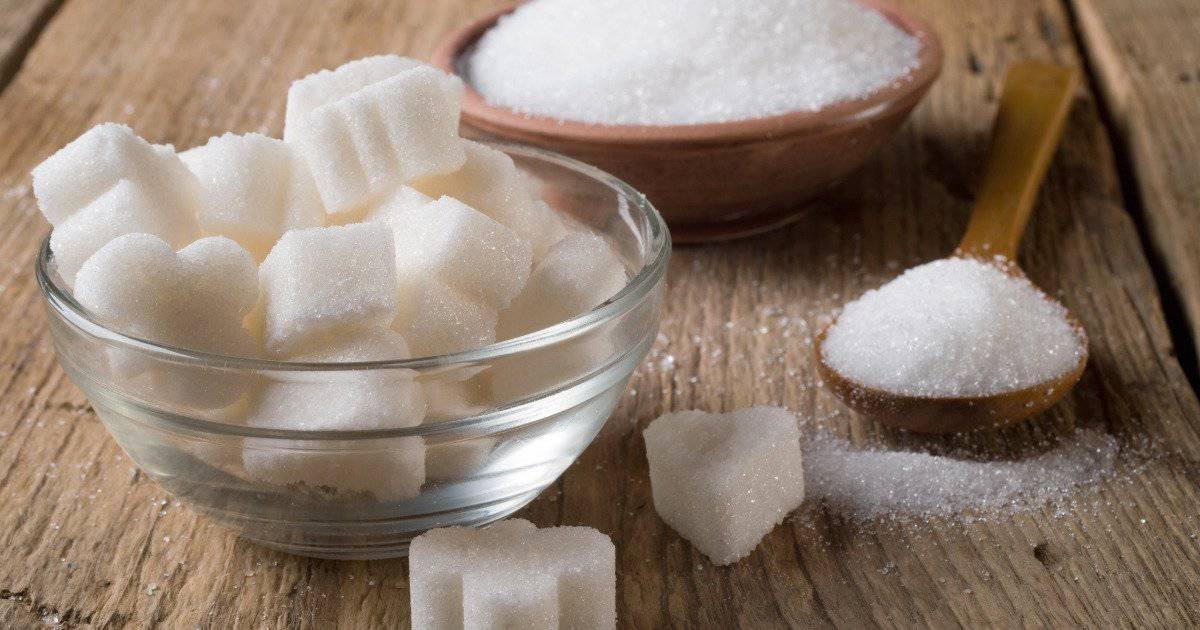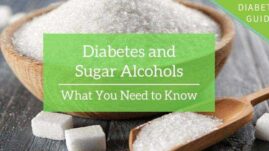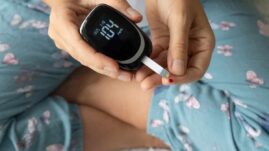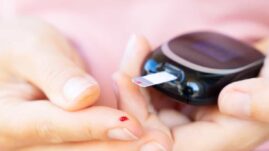If you live with diabetes (type 1, type 2, gestational, or any other kind of diabetes), you know that living with the condition is rife with myths, misinformation, and especially stigma.
There’s a stigma about how we’re supposed to eat, how much we’re supposed to eat, what we’re supposed to eat, and seemingly more than ever, wondering if eating actual sugar has caused our diabetes.
This is more than victim-blaming; misinformation about nutrition in general can be very dangerous to people. But the topic of sugar is a little more complicated; there are nuances and attention to detail that must be paid.
This article will investigate whether or not eating sugar causes diabetes, the implication of eating sugar, and how you can incorporate sweets into your life in a healthy way if you choose to do so.

What happens when you eat sugar?
When you eat sugar (which can be called many things, but a molecule of sugar is made up of one molecule of glucose and one molecule of fructose bonded together), it is released into your bloodstream.
This raises blood sugar levels in people with and without diabetes, and (if you do not have diabetes), it sends a signal to your pancreas to release insulin to lower your blood sugar.
People who have diabetes, in turn, must inject insulin (or take another medication) to bring their blood sugar levels back down.
Insulin takes glucose out of the bloodstream and into your cells, where it can be metabolized for energy.
If you eat more sugar than your body uses for energy, the excess is stored as fatty acids and turns into bodily fat, which causes excess inflammation in the body and can lead to weight gain.
Fructose can be converted directly to fat, with higher intakes leading to an increase in triglyceride levels, which can increase your risk for heart disease and fatty liver disease (think high-fructose corn syrup that’s added to many sugar-sweetened beverages).
High intake of fructose is also associated with the development of gout, a painful joint condition.
In addition to its addictive qualities, sugar in excess can also cause headaches, higher blood pressure, increased risk of cancer, and cavities, not to mention the sluggish feeling of lethargy after a sugar spike and then subsequent crash.
Why is sugar so bad for you?
Sugar is a naturally-occurring carbohydrate that’s found in many fruits, dairy, grains, and even vegetables. Consuming these whole foods that naturally have sugar is fine because they are also full of vitamins, minerals, fiber, and antioxidants that are important for a well-rounded diet.
These healthy foods also slow down the digestion of the sugar/carbohydrates, providing a steady stream of energy, without the crash. They also keep you fuller for longer, as many fruits and vegetables have high water content as well.
The main issue with sugar is when it’s found in processed foods with added sugar. The sugar found in an apple is very different from the sugar found in an ice-cream sundae, and your body can tell the difference.
In the typical American diet, the top sources of added sugar are found in soft drinks (soda), fruit drinks, flavored yogurts, cereals, cookies, cakes, candy, and other processed foods (even bread usually has added sugar!).
In short: Americans are eating way too much added sugar and it’s wreaking havoc on our health.
The average American eats around 22.2 teaspoons of added sugar per day! That’s the equivalent of 355 extra calories. And those calories are empty (have no nutritional value).
It’s recommended that women have no more than 100 calories of added sugar per day (6 teaspoons) and men have no more than 150 calories of added sugar (9 teaspoons) per day, but less is always better because sugar is not a necessary nutrient in any diet.
Does eating sugar cause diabetes?
Eating sugar (strictly speaking) does not directly cause diabetes. It does not cause type 1 diabetes. It does not cause type 2 diabetes. It does not cause gestational diabetes. It does not cause LADA or MODY or any other type of diabetes.
You cannot eat too many candy bars and make your way to a diabetes diagnosis instantly. No matter how many jokes and myths and stigmas abound, sugar does not directly cause diabetes.
However, sugar DOES cause inflammation and insulin resistance in the body, and eating an excessive amount of added sugar can lead to weight gain. This weight gain and insulin resistance, over time, can lead to prediabetes, which if left untreated, usually does develop into type 2 diabetes within 5-10 years.
Many studies have found that drinking sugar-sweetened beverages increases your risk of developing type 2 diabetes by at least 25%. Drinking just one sugar-sweetened beverage per day (and it doesn’t even need to be soda) increases your risk of developing type 2 diabetes by 13%!
Other, correlative studies, have found that countries with the highest sugar consumption also have the highest rates of type 2 diabetes (and with the lowest consumption, the lowest rates).
These correlative links even hold true when other variables are held constant, including total calorie intake, exercise, alcohol consumption, and body weight.
Perhaps most damaging, the consumption of sugar may disrupt the body’s naturally-occurring signaling of the hormone leptin, which regulates hunger and lets the brain know the body is full and sated. This disruption can lead to overeating and weight gain.
Additionally, since added sugars are mostly found in processed foods that don’t have much nutritional value, it’s harder to get full, which makes it incredibly easy to overeat. Think: have you ever eaten too many apples? How about cookies?
It’s important to remember, however, that these studies show sugar increases the risk of developing type 2 diabetes, but do not prove that sugar indeed causes diabetes.
No amount of sugar can cause type 1 diabetes, which is an autoimmune condition not related to one’s metabolic state.
Tipping the scales to a diagnosis
So there can be no direct line drawn from your daily Dr. Pepper habit to a type 2 diabetes diagnosis, but increasing your risk, if you’re already in a high-risk group for developing type 2 diabetes, can spell trouble.
The following are risk factors for developing type 2 diabetes:
- Being overweight or obese
- Have a sedentary lifestyle
- Age 45 or older
- Having a family history of type 2 diabetes
- Are African American, Alaska Native, American Indian, Asian American, Hispanic/Latino, Native Hawaiian, or Pacific Islander
- Have hypertension
- Have low HDL or high triglycerides
- Have a history of gestational diabetes or gave birth to a baby over 9 pounds
- Have a history of heart disease and/or stroke
- Have depression
- Have Polycystic Ovary Syndrome (PCOS)
- Have Acanthosis Nigricans
- Have diagnosed prediabetes
- Have high fasting blood glucose levels
If you have one or more of these risk factors, you need to be careful with the amount of added sugar you consume in your diet.
It can tip the scales into developing insulin resistance and prediabetes, which over time (if left untreated) can develop into type 2 diabetes.
What about artificial sweeteners?
Artificial sweeteners have long been a godsend to the diabetes community: these seemingly magical compounds are man-man, and cannot be metabolized by the human body, even though they can make things extremely sweet.
This means that you can add things like Sweet N Low, Splenda, or Equal to your coffee, tea, or cereal without the added need to bolus insulin (nor suffer from additional calories!).
However, as more research comes out about the unintended consequences of these chemicals, researchers warn to be wary.
Even though they don’t technically raise blood sugar levels, artificial sweeteners have been linked with increased insulin resistance as well as type 2 diabetes. In fact, drinking just one diet soda per day has been found to increase the risk of developing type 2 diabetes by between 25-67%!
The reasons for this are murky; artificial sweeteners increase not only your tolerance for sweet foods but can increase cravings for them as well (as opposed to training your taste buds to not crave sweet things at all).
Artificial sweeteners may also disrupt proper bacteria formation in the microbiome, leading to insulin resistance, weight gain, and the development of prediabetes and diabetes.
The best solution? Opt for naturally sugar-free food and drink, such as fresh fruit and seltzer water with lime.
You can learn more about natural and artificial sweeteners in our guide The Best Sweeteners for People with Diabetes
How to incorporate sweets into your life healthfully
While no amount of sugar is “recommended” by professionals, incorporating sweets into your life can be crucial to maintain not only your mental health but to enjoy life along the way.
Here are some ways to enjoy sugar and sweet foods and drinks, without increasing your risk for type 2 diabetes (especially if you’re already in a high-risk category for the disease):
- Do not eat more than the recommended amount of sugar per day. This is 6 teaspoons per day for women and 9 for men
- Work with your doctor, a registered dietitian, or a nutritionist to formulate a meal plan that will work for you
- Only eat sweet treats occasionally, not every day
- Watch your portion sizes
- Follow a whole foods diet, with plenty of fresh fruits and vegetables
- Reduce your alcohol consumption
- Do not drink your sugar (or calories!); however, remember that artificially-sweetened diet drinks aren’t the best option, either
Conclusions
Eating sugar does not directly cause any type of diabetes. However, eating sugar regularly in excess can greatly increase your risk for developing insulin resistance, prediabetes, and eventually, type 2 diabetes.
Artificial sweeteners do not contain sugar (nor added calories), so they are better for preventing the development of cavities. However, they have also been correlated with the development of weight gain and type 2 diabetes.
Limit your sugar intake, and incorporate whole foods, including lots of fresh fruits and low-carb vegetables, that have naturally-occurring sugars, that pose no threats to your health.
Fresh fruits, vegetables, grains, and dairy may contain naturally-occurring sugars, but are also full of fiber, vitamins, minerals, and antioxidants, making them a healthy alternative to added sugars and artificial sweeteners.
Work with your doctor, a registered dietitian, or a nutritionist to make a meal plan that will work for you, your lifestyle, and your health goals.




Ali
There is no mention of plant based sweeteners that don’t raise blood sugar such as erythritol, monk fruit, stevia
John Doe
Just 2 years ago I was diagnosed with diabetes. My situation was pretty desperate as my blood sugar levels were getting higher and higher and my health was deteriorating. I was gaining weight, my eye sight was getting worse, and my family was getting worried. However, after I followed the steps in the program I found here ( diabetes.best-remedy.info ) I no longer have to worry about checking my blood sugar multiple times a day. I no longer have to worry about injecting insulin into my body every day. My life has changed for the good.
Anthony F DeStefano
Thank you for all you do,
Last year I weighed 232lbs and my height was 5’8. I was a diabetic 2 for 30 years on 500 Insulin and Insulin pump for 18 years. I always rode my bike at least 5 miles per day but never experienced any positive result. Using an Apple Watch 1 it would record the results and time. Example: bike ride 150 cal, time 25 minutes. I replaced my Apple Watch 1 with an Apple Watch 6. When I checked my progress. a 45 minute walk would only register as a 8 minute walk. Bike rides on a flat surface recorded very little exercise. Called Apple support because I thought something was wrong with the Watch. I was told by support if you heart rate is not increasing you are not really get sufficient exercise.
They recommended walking fast, running, riding bike uphill.
So being 67 years old I started walking 1/4 mile then running few hundred feet on our community 2 mile outdoor track. I noticed if I ran after eating my glucose number went down without insulin.
Today after 9 months I weigh 142 pounds, and run 2 miles everyday.
The results: no more insulin, no more blood pressure meds, no meds period, today going on 68 I feel like 21. Survivor of colon cancer, stage 3 lung cancer and two heart attacks. My cardio fitness is now 34.5 started at 18..If I can do it anyone can, Never in a million years though I would be classified as a non diabetic. I learned a lot from news letters regarding what to eat. I thought eating instant oatmeal was good until I found out my glucose would shoot up from 120 to 260. Now I eat steel cut that takes 30 minutes to cook and no spikes, the less something is processed the less spikes. Diet and exercise,
By the way I run everyday 2 miles and it only take 20 to 25 minutes, very small price to be off insulin and now only seeing a primary care doctor and cardiologist once per year. My Health Insurance company is in shock, saving them 5,500.00 per month for 500 insulin and pump supplies and constant doctor appointment
Please give it a try, I wished I did this 30 years ago, I watch both of my parents die due to diabetes. Mis information, being told insulin is not a drug it’s made naturally in your body and take all you need, which meant to me eat all you want and pump it in. After a while regular insulin 100 was no sufficient and started using 500. If the health provider is not trying to get you off insulin they find a new provider.
Sincerely
Anthony D